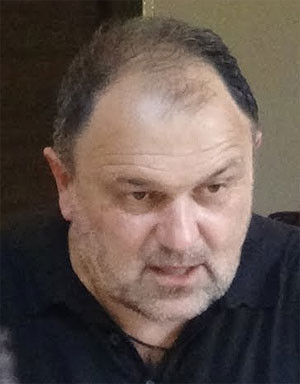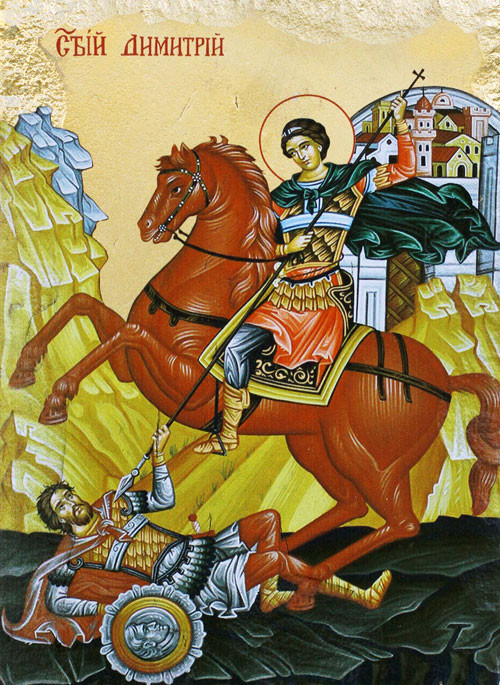Today, 26 October the Bulgarian Orthodox Church commemorates Holy Great Martyr Demetrius of Thessaloniki (St. Dimitar). Greeks, Bulgarians, Russians and Serbs all vie for his intercession.
Assoc. Prof. Dr. Pavel Pavlov from the Faculty of Theology of the St. Kliment Ohridski University, Sofia says that “St. Dimitar is a major Balkan patron saint,” and that the veneration for him, especially over the first millennium can be explained with the “proximity of the towns where he preached and where he was ultimately tortured –Sirmium (Sremska Mitrovica) – the capital city of Pannonia within the bounds of the Roman Empire”. During the second millennium worship of the saint spread to other regions, reaching Asia Minor.
 “There is logic behind the church calendar of saint days, connected with the life of a given saint, with a specific event or the translation of holy relics. For St. Dimitar that day falls at the end of October, the day on which the church gathers together its flock after the long summer and the hard work in the field. People who have been working abroad come home, and on the day of St. Dimitar families come together. A new, internal family cycle of life begins for the church and for families. The weather changes, there is no more work out in the fields, and families are brought together in anticipation of the major feast – Nativity – which the church begins to make mention of from the time of the Nativity of the Blessed Virgin Mary in early September.”
“There is logic behind the church calendar of saint days, connected with the life of a given saint, with a specific event or the translation of holy relics. For St. Dimitar that day falls at the end of October, the day on which the church gathers together its flock after the long summer and the hard work in the field. People who have been working abroad come home, and on the day of St. Dimitar families come together. A new, internal family cycle of life begins for the church and for families. The weather changes, there is no more work out in the fields, and families are brought together in anticipation of the major feast – Nativity – which the church begins to make mention of from the time of the Nativity of the Blessed Virgin Mary in early September.”
Assoc. Prof. Pavlov explains that “in frescoes, St. George and St. Dimitar are depicted as warrior-saints, shoulder to shoulder, or standing opposite one another, and that in the Balkans all veneration seems to begin with veneration of the holy great martyrs St. George and St Dimitar.”
Since the church describesSt. Dimitar as a warrior of Christ and a martyr, can we say that every saint has his Golgotha?
“Every saint has his ordeal,” says Assoc. Prof. Pavlov. “Martyrs, especially in the 3rd and 4th century AD are more often than not from the army. The army is a place where personal behavior was closely scrutinized and Christians were easy to pick out. They refused to honour pagan gods, declaring their Christian faith, and their lives were taken. There are many nameless Christians who have lost their lives for their faith. On 2 September the church honours all those thousands of martyrs from Nicomedia. There are so many martyrs, but St. George and St. Dimitar stand out among them. They lived in the early 4th century, under Emperor Diocletian when the persecution of Christians in the early history of the church reached its peak. St. George was martyred in Nicomedia, the capital of the Eastern Roman Empire, and St. Dimitar – in Thessaloniki.”

But St. Dimitar also has a connection with the Second Bulgarian Kingdom. Assoc. Prof. Pavlov:
 “That is an important moment for St. Dimitar. According to George Akropolites and other sources from the end of the 12th and the beginning of the 13th century, when the Normans came to the Balkans they started uprooting existing tradition. They conquered Thessaloniki, pillaged the St. Dimitar church, but the saint prevented them from burning his miracle-working icon and it found its way to Turnovo. This helped the 1185 uprising of Asen and Peter which brought about the restoration of the statehood of Bulgaria. After a dispute with the emperor in Constantinople, Asen and Peter returned to Turnovo offended. They saw the arrival of the icon as a sign that the saint patronized the old Bulgarian capital and built the St. Dimitar of Thessaloniki Church where they placed the miracle-working icon. During the time of the Bulgarian National Revival, the time of the Bulgarian-Greek schism, St. Dimitar is depicted as a horseman spearing a man. It is said that that man is Tsar Kaloyan, killed in his tent in front of the city walls of Thessaloniki on 8 October 1207. That is the other side of the interpretation – that the saint returned to his town to become its patron and protect it from the threat of being conquered by Asen and Peter’s brother – Tsar Kaloyan. There is an erroneous interpretation here because at that time the town was in the hands of the crusaders. So, when making interpretations we should never forget actual facts. Historians do not agree on how the icon of St. Dimitar ended up in Turnovo. The best way to interpret this is to say that the saint himself went to the place where he was held in highest esteem.”
“That is an important moment for St. Dimitar. According to George Akropolites and other sources from the end of the 12th and the beginning of the 13th century, when the Normans came to the Balkans they started uprooting existing tradition. They conquered Thessaloniki, pillaged the St. Dimitar church, but the saint prevented them from burning his miracle-working icon and it found its way to Turnovo. This helped the 1185 uprising of Asen and Peter which brought about the restoration of the statehood of Bulgaria. After a dispute with the emperor in Constantinople, Asen and Peter returned to Turnovo offended. They saw the arrival of the icon as a sign that the saint patronized the old Bulgarian capital and built the St. Dimitar of Thessaloniki Church where they placed the miracle-working icon. During the time of the Bulgarian National Revival, the time of the Bulgarian-Greek schism, St. Dimitar is depicted as a horseman spearing a man. It is said that that man is Tsar Kaloyan, killed in his tent in front of the city walls of Thessaloniki on 8 October 1207. That is the other side of the interpretation – that the saint returned to his town to become its patron and protect it from the threat of being conquered by Asen and Peter’s brother – Tsar Kaloyan. There is an erroneous interpretation here because at that time the town was in the hands of the crusaders. So, when making interpretations we should never forget actual facts. Historians do not agree on how the icon of St. Dimitar ended up in Turnovo. The best way to interpret this is to say that the saint himself went to the place where he was held in highest esteem.”
English version: Milena Daynova
Photos: archiveThere are rumours and speculations that some forgeries, so good that they are not inferior to the originals, could be found among the exhibits in the museums, but at the moment a whole series of forgeries can be seen at an exhibition..
A unique statue from the Roman period of Odessos, preliminarily dated to the late 2nd to the first half of the 3rd century, has been discovered during excavation works near the train station in Varna, said archaeologists from the Varna Regional..
Petrich municipality has received an award for original promotion of the tourist destination Heraclea Sintica , Katya Stoyanova, head of the "Restoration, conservation and socialization of Heraclea Sintica" project, said this for BTA. The award..
The head of the statue of Tyche, the goddess of Philippopolis, has been discovered in the Episcopal Basilica in Plovdiv, said the head of the..

+359 2 9336 661
